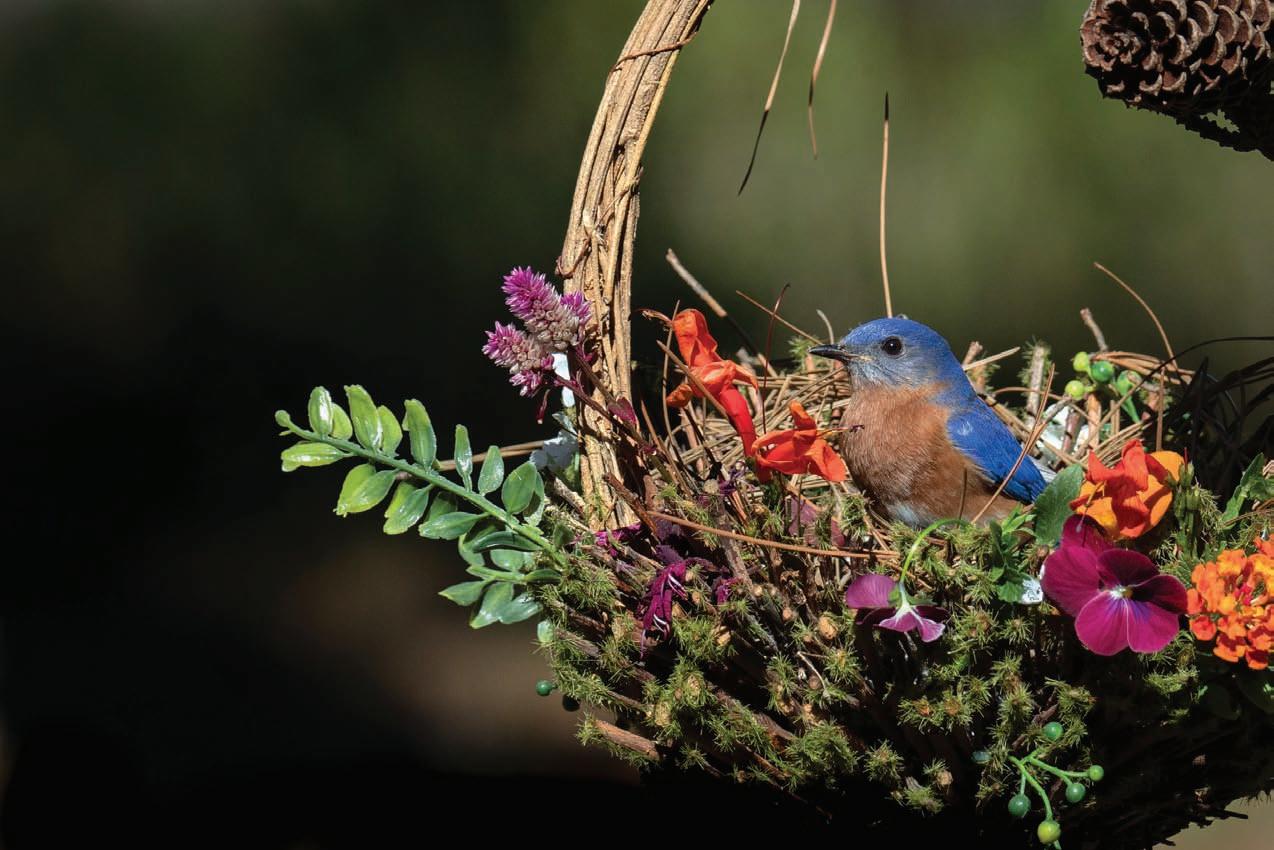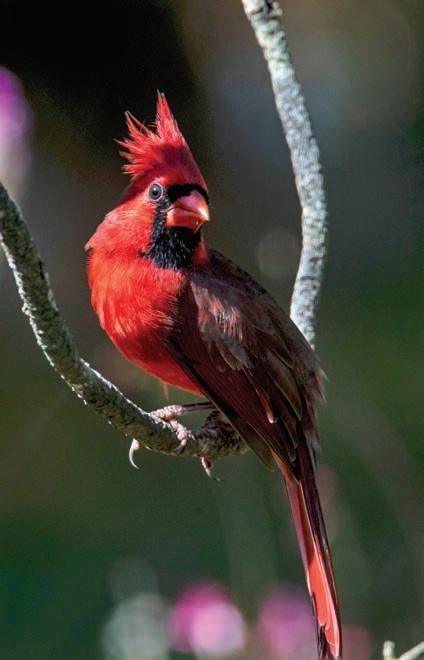
6 minute read
Birds & Blossoms
Birds & blossoms
Advertisement
STORY AND PHOTOS BY GAIL E. PFOH


Eastern Bluebird
If you love birds and or blossoms, this might be your favorite time of the year. Blossoming shrubs and flowers on and around Amelia Island, such as azaleas and bottlebrush bushes, are in full bloom. Perching on these as they sing are incredibly beautiful birds.
Our area is bursting with color this spring, like the vivid blue of our Eastern Bluebirds, the crimson red of male Northern Cardinals, and the emerald green of Ruby-throated Hummingbirds. Their colors brighten our days and heighten our awareness of why we love living or visiting here.
You can increase your chances of seeing these beauties, and other colorful “neighbors,” by planting native plants and providing some water and food to supplement their diet. Local birds such as Carolina Wrens, Tufted Titmice, and Pine Warblers are nesting now. Breeding season means the adult birds need more nourishment because of the demands of parenting, and they have the added burden of providing food to their nestlings. Th ese and other birds would be happy to find black oil sunflower seeds and homemade or store-bought suet in your yard.
The Cornell Lab of Ornithology notes that Pine Warblers are “yellowish birds with olive backs, whitish bellies, and two prominent white wingbars on gray wings. Adult males are the brightest; females and immatures are more subdued and can even appear gray-brown.” Pine Warblers weigh less than one penny and have a wingspan of approximately 8.5 inches. They enjoy finding suet in your yard.
Painted Buntings have recently returned to the island and surrounding areas. With his brilliant blue head, greenish back, and red rump and belly, the male Painted Bunting is one of the most colorful birds found breeding in the United States. Th e female, as well as the immature male, is a bright yellow/green. Birders often call the females and immature males “greenies.” Th e only way to be sure if a Painted Bunting is a male is if you see the bird singing. Only the male Painted Bunting sings.
Painted Buntings spend their breeding season here before moving south in the fall. To attract them, be sure to offer a fresh supply of white millet in your feeders. A tube feeder with small perches works well for them and keeps larger birds away. Like all birds, they enjoy fresh water from a fountain or clean birdbath.
Eastern Bluebirds with their royal blue and red coloring are always popular. They weigh only about one ounce.

Northern Cardinal
Downy and Red-bellied Woodpeckers are nesting now. They are year-round residents here. They love peanuts as well as suet, as do other species like Brown-headed Nuthatches and Carolina Chickadees. During warm months, only put out small amounts of suet to be sure it does not spoil. Don’t hesitate to slice your suet before putting it outside. You can freeze homemade suet so you always have a fresh supply.
Hummingbirds and warblers love the blossoms of bottlebrush bushes. Th ese shrubs are evergreen, hardy, and easy to grow. They bloom twice a year in spring and fall, which is a welcome treat for migrating birds. Talk to a local nursery to learn about native plants, which beautify your yard and feed and nourish birds and butterflies.
To enjoy backyard birds, always keep feeders and birdbaths clean. For reliable information on birds, visit the Cornell Lab of Ornithology’s website at allaboutbirds.com.
superb shrubs

While enjoying the good weather in your garden this month, consider adding a few new shrubs for screening or interest, like Olive Martini and Sunshine Ligustrum.
BY BETTY MORRELL
April is one of the best months of the year to plant in the garden. Everything is so fresh and vibrant, with new leaves on the trees, new sprouts on the plants, new buds on the flowers, new seedlings popping up from last season, and a few wind-blown surprises. No surprise are the weeds!
The beautiful Azaleas have outdone themselves in welcoming the spring. Their awesome colors always catch the eye. Encore Azaleas will continue to bloom throughout the year. I was also greeted by bands of gold and yellow Lantana in my garden. I cut them way back in the fall, and they have come back with a vengeance. Th ey stand out, but like a weed, they need to be controlled.
Walking through a nursery recently, I came across a new Eleagnus, a unique and beautiful Southern Living shrub called Olive Martini (PP). Th is plant produces vibrant foliage, edged in gold, that creates a striking display on sunny borders. It has a dense upright habit.
Eleagnus is salt-tolerant, and left to do its own thing, will create wonderful screening 10 to 15 feet high and wide, or it can be shaped into an attractive shrub. Its sturdy structure and consistent color, along with its silvery new growth, adds seasonal interest to this evergreen shrub.
I love plants in the landscape that vary in color, texture, and height. One fi tting that category is a Southern Living (PP) plant called Sunshine Ligustrum, a showy eye-catching evergreen shrub with year-round golden foliage. It fl ourishes in the sun. Sunshine grows 3 to 6 feet in height and 3 to 4 feet wide. It’s perfect for a backdrop, or you can trim and shape it to your liking.
This shrub’s new growth starts out a lime green color and continuously intensifies to yellow hues in spring, then ushers in summer with vibrant golden yellow. It’s so beautiful. Plant it in full sun and fertilize yearly in spring. Sunshine pairs beautifully with Purple Pixie Loropetalum in front (the dwarf weeping one I mentioned last month).
Meerlo Lavender is a stunning, aromatic plant. It has proven to be one of the most heat- and humidity-tolerant plants for our area. Th is hardy perennial has brightly variegated green and creamwhite serrated foliage that produces a wonderful fragrant aroma. A multitude of pale purple-blue flowers appear during the summer. After the blooms have faded, trim it back to keep this plant in its compact form.
Meerlo is perfect for containers and as a stunning addition to landscapes, flowerbeds, borders, low hedges, or even as a specimen. Plant it anywhere you have sun to part-shade. In mass plantings or solid borders, place each one 18 to 20 inches apart. Average size is 24 to 36 inches high and 24 to 30 inches in width. They attract birds and butterflies.
Christy and I are doing virtual and onsite consultations. Email me at bamorrell@aol.com with any questions. In the meantime, Happy Gardening!
TIP OF THE MONTH
If your azaleas have fi nished blooming, trim and shape them, or cut back and fertilize them with an acid fertilizer. Use the same fertilizer for your gardenias, hydrangeas, holly, hibiscus, and ground orchids.








